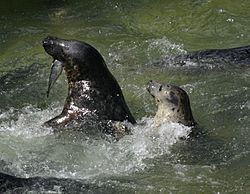Cornish Seal Sanctuary facts for kids
 |
|

Seals at the sanctuary
|
|
| Date opened | 1975 |
|---|---|
| Location | Gweek, Cornwall, England |
| Coordinates | 50°05′31″N 5°12′09″W / 50.091968°N 5.202633°W |
The Cornish Seal Sanctuary is a special place in Cornwall, England, UK. It helps injured baby seals, called pups, and other sea animals. The sanctuary is owned by The SEA LIFE Trust. You can find it by the Helford River, near the village of Gweek.
Contents
A Helping Hand for Seals
The idea for the seal sanctuary began in 1958. A man named Ken Jones found a baby seal washed up on a beach near his home. This first rescue led to many more. By 1975, Ken's work had grown too big for his small pool. A new, larger home was needed.
That's when the sanctuary moved to Gweek. The new site slowly grew over time. Today, it has five pools and a special hospital. This allows the sanctuary to care for many seals at once.
Rescuing and Releasing Seals
The sanctuary helps many seal pups every year. They often care for sixty to seventy pups. In 2018, they rescued over eighty pups from the wild. Young seals often need help because they are separated from their mothers. They might also get tangled in ocean litter. The main goal is to help them get healthy and then release them back into the sea.
How a Rescue Happens
A rescue usually starts with a phone call about a pup that seems to be alone. If the rescue team thinks the pup is in danger, they will carefully catch it. Then, they take the pup to the sanctuary.
Once at the sanctuary, the pup gets a full health check. The team decides on the best treatment. Many pups are very thin and have infected wounds.
Getting Better and Learning
When a seal starts to recover and gain weight, it moves to a special pool. Here, it can meet other recovering seals and even some seals that live at the sanctuary full-time. This helps the pups learn how to find and compete for food.
After a few months, the seal is strong and healthy. It is then released back into the sea. The team tries to release each seal close to where it was first found. Before they go, each seal gets a small tag on its flipper. Recently, they also use a hat tag that falls off when the seal sheds its fur. These tags help the sanctuary learn how well the rescued seals survive in the wild.
Permanent Residents
The sanctuary tries to release almost all the pups they rescue. Between 1981 and 2013, only four seals could not go back to the wild. These seals became permanent residents at the sanctuary. They stay because of health issues or because they have been in captivity for too long. Some of these long-term residents share pools with the rescue pups. They even help by showing the younger seals how to compete for food at meal times.
Other Animals at the Sanctuary
Besides seals, the sanctuary is also home to other amazing animals. You might see:
- California sea lion (Zalophus californianus)
- Southern sea lion (Otaria flavescens)
- Humboldt penguin (Spheniscus humboldti)
- Asian short-clawed otter (Amblonyx cinereus)
- Common seal (Phoca vitulina)

